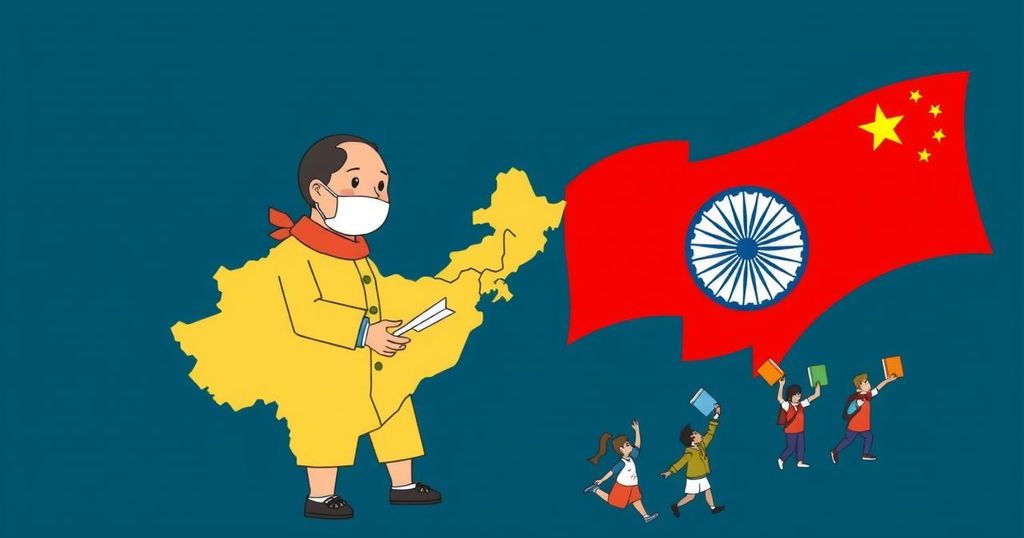The educational divergence between China and India has shaped their economic policies and outcomes. While China prioritized vocational training and broad educational access, India focused on elite tertiary education, which has resulted in China’s superior economic growth and per capita income. Understanding these educational histories is crucial in navigating the future economic landscape of both nations.
The competition between China and India, the world’s two most populous nations, can largely be attributed to their distinct educational approaches over time. Beginning in the early 1990s, China emerged as a manufacturing powerhouse, whereas India’s focus remained on service-oriented sectors like software. As a result, despite substantial economic growth in both countries, China’s per capita income has eclipsed India’s by over two-fold, illustrating the impact of their respective educational trajectories on overall productivity and economic success. The insights gathered in “The Making of China and India in 21st Century” by Nitin Kumar Bharti and Li Yang highlight the significance of education in shaping the development of these nations. Historical records indicate that, by the early 1900s, India had an eightfold greater student population compared to China due to its substantial earlier exposure to Western educational practices. Despite China’s slow start, the abolishment of its traditional Imperial examination system ultimately allowed for accelerated educational growth, resulting in parity in enrollment rates by the 1930s. Intriguingly, the educational philosophies of the two nations diverged sharply post-independence. While India prioritized tertiary education to produce a limited elite workforce, China emphasized broader access to quality primary and secondary education. This foundational strategy cultivated a larger pool of skilled labor, contributing to China’s advantage in engineering and vocational fields. Recent studies reveal that China’s emphasis on producing engineers rather than social scientists is a critical factor behind its rapid industrial progress. Furthermore, China’s proactive stance on adult education has enabled millions to achieve literacy skills, thus bolstering its workforce capacity and overall economic trajectory. In light of historical educational biases introduced during colonial rule, India continues to grapple with disparities in educational access and quality. In conclusion, the educational pathways chosen by China and India have diverged significantly, resulting in differing economic outcomes. The emphasis on a well-rounded educational system in China has proven beneficial for its manufacturing-focused economy. Meanwhile, India’s reliance on an elitist approach fosters challenges in generating a sufficiently skilled workforce. Understanding these historical contexts is crucial for formulating future educational policies that can enhance India’s economic competitiveness on the global stage.
The competitive dynamics between China and India have been influenced heavily by their respective approaches to education and workforce development throughout the 20th and 21st centuries. The early advantages that each nation held, based on their colonial legacies and subsequent educational policies, establish a framework for understanding their current economic states. This analysis recognizes that education is not merely a sector but a foundational element influencing broader economic viability and human capital development. China’s strategic enhancements to its educational systems, coupled with a focus on vocational and engineering skills, have positioned it as a leader in various advanced industries. In contrast, India’s historical focus on service-based educational pathways has generated a different labor market outcome, emphasizing the importance of educational choices in shaping national prosperity. The differences in demographic policies and political frameworks further complicate these dynamics, setting the stage for an ongoing rivalry that is as much about education as it is about economics.
In summary, the educational distinctions between China and India serve as pivotal factors underpinning their divergent economic trajectories. China’s commitment to providing broad access to education and fostering technical expertise has truly driven its manufacturing successes and overall economic development. Conversely, India’s prioritization of elite tertiary institutions without sufficient foundational education has hindered its ability to leverage its demographic advantages fully. To enhance its competitiveness, India must reassess its educational policies and strategies, focusing on inclusivity and skills training that align with current economic demands.
Original Source: www.livemint.com






